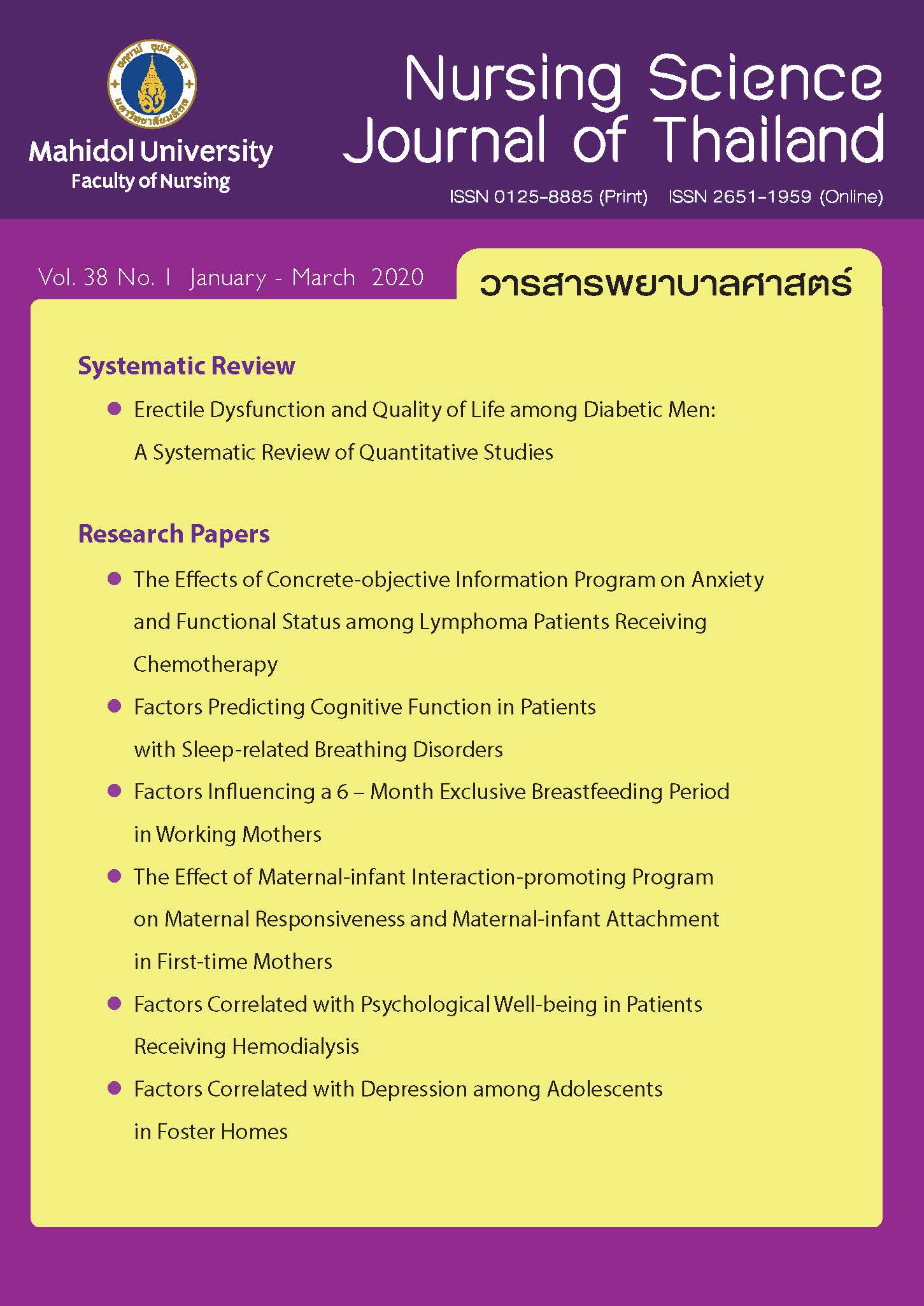Factors Correlated with Depression among Adolescents in Foster Homes
Main Article Content
Abstract
Purpose: To examine the prevalence of depression and the relationships of intelligence quotient, history of being abused, self-esteem and social support with depression among adolescents in foster homes.
Design: Descriptive correlational study.
Methods: The sample consisted of 100 adolescents with 10-19 years of age retrieved from 4 foster homes. Data were collected by using 4 instruments: the demographic questionnaire, the Children’s Depression Inventory, the revised version of the Rosenberg Self-Esteem Scale, and a revised Thai Multi-dimensional Scale of Perceived Social Support. Descriptive statistics, Pearson’s product moment correlation, point bi-serial correlation, and t-test were used for data analysis.
Main findings: The findings revealed that the prevalence of depression in this sample was 48 percent. History of being abused was significantly and positively correlated with depression at a moderate level (r = .409, p < .01). Additionally, self-esteem and social-support were negatively correlated with depression at a moderate level and at a low level (r = - .639, p < .01; r = - .313, p < .01, respectively). However, intelligence quotient was not correlated with depression in adolescents in foster homes.
Conclusion and recommendations: History of being abused, self-esteem and social support were significantly correlated with depression in adolescents in foster homes. Screening for depression among adolescents in foster homes is highly recommended, especially in adolescents with a history of being abused. Mental health promotion program should be emphasized on self-esteem and social support in order to enhance psychological well-being and reduce a prevalence rate of major depressive disorder among adolescents in foster homes.
Article Details
Copyright Notice: Nursing Science Journal of Thailand has exclusive rights to publish and distribute the manuscript and all contents therein. Without the journal’s permission, the dissemination of the manuscript in another journal or online, and the reproduction of the manuscript for non-educational purpose are prohibited.

Disclaimer: The opinion expressed and figures provided in this journal, NSJT, are the sole responsibility of the authors. The editorial board bears no responsibility in this regard.
References
World Health Organization. Depression [Internet]. Geneva, Switzerland: World Health Organization; 2016 [cited 2019 Jun 30]. Available from: https://www.who.int/news-room/fact-sheets/detail/depression.
Substance Abuse and Mental Health Services Administration. Results from the 2013 national survey on drug use and health: mental health [Internet]. Rockville, MD: Substance Abuse and Mental Health Services Administration; 2014 [cited 2019 Jun 30]. Available from: https://store.samhsa.gov/system/files/nsduhmhfr2013.pdf.
Department of Mental Health. World Health Day 2017, Depression: Let's talk [Internet]. Nonthaburi: Department of Mental Health; 2017 [cited 2019 Jun 30]. Available from: https://www.thaidepression.com/www/who_depress/km_depress.pdf. (in Thai).
Ministry of Social Development and Human Security. Child Protection Act, B.E. 2003 [Internet]. Bangkok: Ministry of Social Development and Human Security; 2016 [cited 2019 Aug 10]. Available from: https://law.m-society.go.th/law2016/law/view/19. (in Thai).
The Center for the Protection of Children's Rights Foundation. Impacts on abused children [Internet]. Bangkok: The Center for the Protection of Children's Rights Foundation; 2017 [cited 2019 Jun 30]. Available from: https://www.thaichildrights.org/wp-content/uploads/2018/03/effect_child_abuse1.pdf. (in Thai).
Ramagopal G, Narasimhan S, Devi LU. Prevalence of depression among children living in orphanage. Int J Contemp Pediatrics. 2016;3(4):1326-8. doi: 10.18203/2349-3291.ijcp20163670.
Priyanka, Parasar A, Dewangan RL. A comparative study of self-esteem and level of depression in adolescents living in orphanage home and those living with parents. Int J Humanit Soc Sci Res. 2018;4(2):51-3.
Kongpetch S, Suntibenjakul S. Prevalence of depression and conduct behaviors for adolescents (10-15 years old), at Rajvithi Home for Girls. Chulalongkorn Medical Journal. 2015;59(1):103-14. (in Thai).
Engel GL. The need for a new medical model: a challenge for biomedicine. Science. 2013;196(4286):129-36. doi: 10.1126/science.847460.
Emerson E. Prevalence of psychiatric disorders in c
hildren and adolescents with and without intellectual disability. J Intellect Disabil Res. 2003;47(1):51-8. doi: 10.1046/j.1365-2788.2003.00464.x.
Hatton C, Emerson E, Robertson J, Baines S. The mental health of adolescents with and without mild/moderate intellectual disabilities in England: secondary analysis of a longitudinal cohort study. J Appl Res Intellect Disabil. 2018;31(5):768-77. doi: 10.1111/jar.12428.
Haenjohn J. Brain & emotions: a miracle connection. Ratchaphruek Journal. 2015;13(3):9-19. (in Thai).
Lotrakul M, Sukanich P. Ramathibodi essential psychiatry. 4th ed. Bangkok: Department of Psychiatry, Faculty of Medicine Ramathibodi Hospital, Mahidol University; 2015. 625 p. (in Thai).
Santrock JW. Adolescence. 15th ed. New York, NY: McGraw-Hill Education; 2014. 472 p.
Sangon S, Nintachan P, Kingkaew J. Factors influencing depression in Thai disadvantaged adolescents in a province in the central region. The Journal of Psychiatric Nursing and Mental Health. 2018;32(2):13-38. (in Thai).
Chanralaksana N, Thaweekoon T, Sangon S. Factors predicting depression in secondary school students. The Journal of Psychiatric Nursing and Mental Health. 2015;29(2):128-43. (in Thai).
Jayanthi P, Rajkumar R. Is low self-esteem a risk factor for depression among adolescents? An analytical study with international component. Int J Med Res Health Sci. 2014;3(3):627-33. doi: 10.5958/2319-5886.2014.00408.1.
Asif A. Self-esteem and depression among orphan and non-orphan children. Dubai, UAE: MedCrave Group LLC; 2017. 29 p.
Safdar S. Comparative analysis of childhood depression and self esteem among orphan girls and boys. Journal of Psychology and Clinical Psychiatry. 2018;9(1):22-6. doi: 10.15406/jpcpy.2018.09.00498.
Nyagwencha SK, Munene A, James N, Mewes R, Barke N. Prevalence of symptoms of post-traumatic stress, depression and anxiety among abused and neglected adolescents in charitable children’s institutions in Nairobi. American Journal of Applied Psychology. 2018;7(2):37-43. doi: 10.11648/j.ajap.20180702.12.
Demoze MB, Angaw DA, Mulat H. Prevalence and associated factors of depression among orphan adolescents in Addis Ababa, Ethiopia. Psychiatry J. 2018;2018:5025143. doi: 10.1155/2018/5025143.
Trangkasombut U, Likhanalikhitkul D. Depressive symptoms in children’s: study using children’s depression inventories. Journal of the Psychiatric Association of Thailand. 1996;41(4):221-34. (in Thai).
Wongpakaran T, Wongpakaran N. A comparison of reliability and construct validity between the original and the revised version of the Rosenberg Self-esteem Scale. Psychiatry Investig. 2012;9(1):54-8. doi: 10.4306/pi.2012.9.1.54.
Wongpakaran N, Wongpakaran T. A revised Thai multi-dimensional scale of perceived social support. Span J Psychol. 2012;15(3):1503-9.
Wiangchai P. Physiological response to stress [Internet]. Bangkok: The Institute for the Promotion of Teaching Science and Technology; 2015 [cited 2019 Jul 5]. Available from: https://biology.ipst.ac.th/?p=2767. (in Thai).


